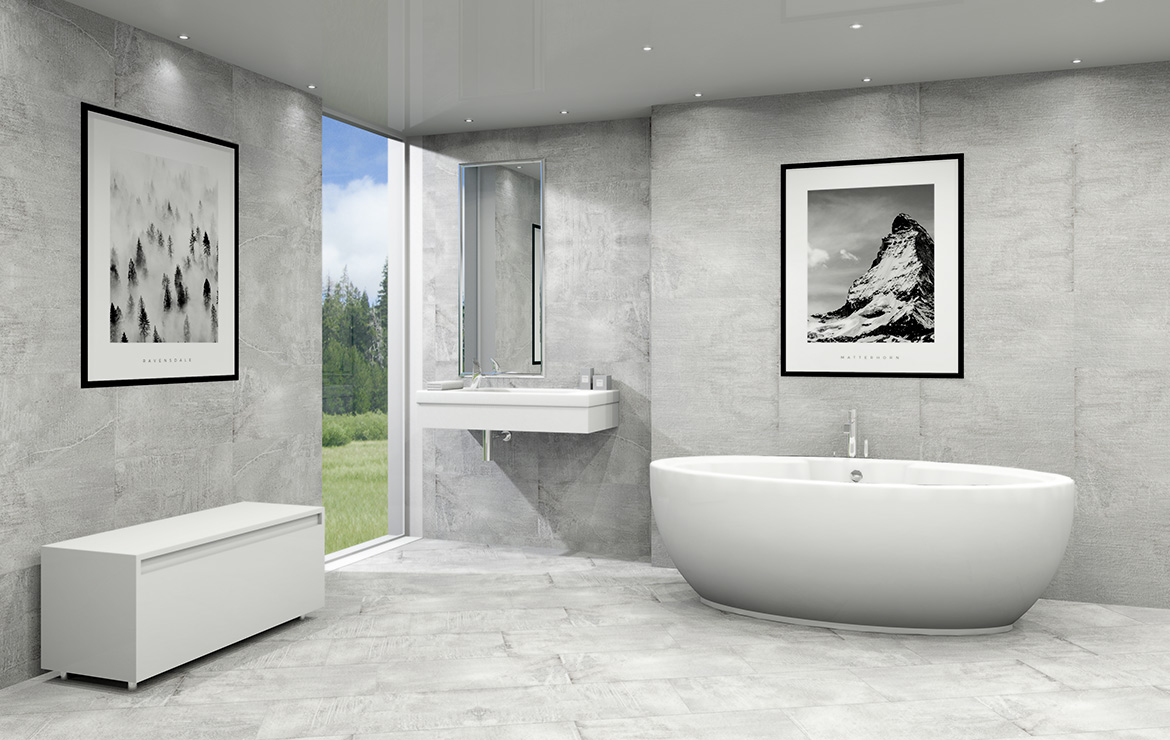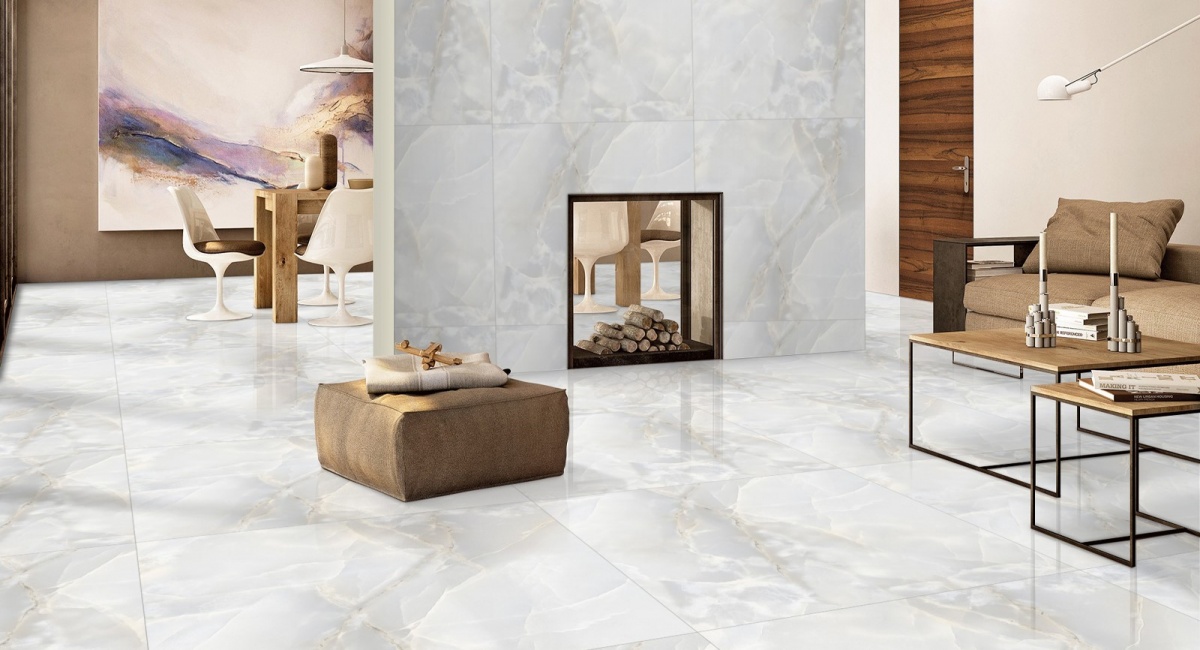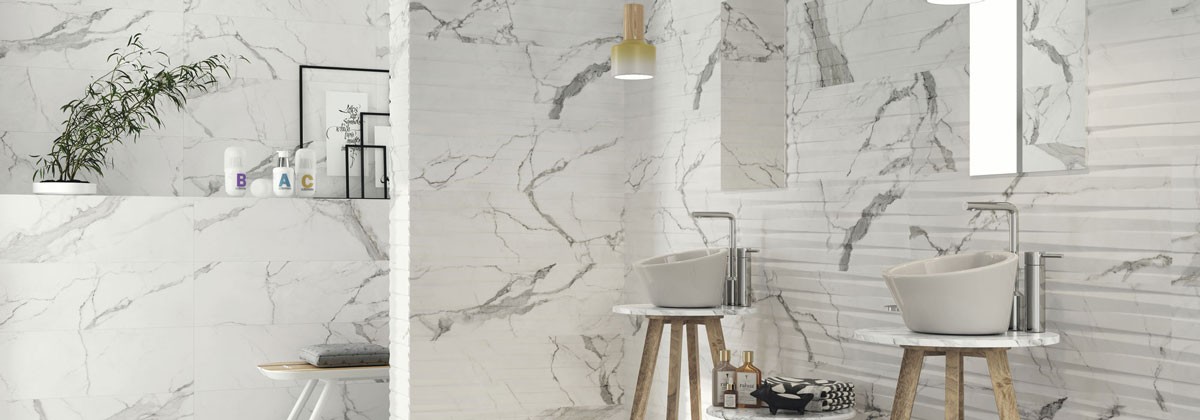Porcelain vs. Ceramic Tile: How to Choose the Best Type for You
When considering porcelain versus ceramic tile, both tiles fall in the category of ceramics: rigid tiles created from natural earthen clays and hardened by heat.
But only porcelain tile has a water absorption rate of 0.5-percent or less. Plus, porcelain tile carries an industry-accepted certification verifying that it is impervious to water.
Porcelain’s fine kaolin clay helps it meet water absorption rate standards. The finer clay and higher firing temperatures result in higher prices for porcelain than for ceramic tile.

Porcelain Tile
Porcelain tile is a dense, smooth-faced, kaolin-rich tile that is more impervious to water than ordinary ceramic tile.1
The clay mixture in porcelain tile is finer and purer than ceramic clays. It usually contains notable levels of quartz and feldspar mixed in. Porcelain tiles are fired at temperatures ranging from 2,200 to 2,500 degrees Fahrenheit.
Porcelain tile is dense and impervious to water, making it suitable for outdoor use in mild climates. Always check the manufacturer’s specifications first since not all porcelain tile can be used outside.
Porcelain tile is tested for water absorption. Low-absorption tile is awarded a PTCA Certification Mark from The Porcelain Tile Certification Agency.
Porcelain tile costs more than ceramic tile. Only 21 companies make or sell porcelain tile, and between these companies, the total number of porcelain tile lines numbers under 400.
So, the selection of porcelain tiles is far less than the section of tiles in the broader ceramic category that do not carry the porcelain designation.
Ceramic Tile
Ceramic tile is a clay-based, heat-hardened tile, often glazed on top for protection.
Ceramic tile is made with an overall coarser mix of clay than porcelain tile. It does contain fine kaolin clay but at a lower ratio than for porcelain tile. It also lacks some porcelain’s clay additives.
Ceramic tile is fired at lower temperatures than porcelain tile, generally about 1,800 to 2,000 degrees Fahrenheit.
Ceramic tile is more susceptible to moisture infiltration than porcelain tile. As long as the face of the ceramic tile is glazed and in good condition, the face will resist water. Unglazed portions of the back or side of the tile will not resist water.
Ceramic tile’s lower firing temperatures partially account for the porcelain versus ceramic tile cost difference: up to 30- to 40-percent less than porcelain. Less energy devoted toward firing means lower tile prices.

How to Tell Porcelain and Ceramic Apart
Porcelain tile and ceramic tile are often manufactured with the same glazed surface coating, so they are visually indistinguishable on top. Though the tile bodies are made with different materials, the bodies still look the same.
Porcelain tile: Boxes of porcelain tiles will display the PTCA Certification Mark. This is the green and gray logo that reads “Certified Porcelain Tile 0.5% Water Absorption,” with a diamond-shaped tile forming the “O” of porcelain. Or check The Porcelain Tile Certification Agency’s list of certified product lines.
Ceramic tile: Ceramic tile has no distinct visual identifiers or product certification badges.
Heat and Water Resistance
Both porcelain and ceramic tile resist heat well and are sometimes used on countertops. Porcelain absorbs less water than ceramic tile.
Porcelain tile: Porcelain has slightly better water resistance, making it more likely to be suitable for outdoor locations in regions with mild climates.
Ceramic tile: Ceramic tile is generally not recommended for outdoor locations in any environment.
Care and Cleaning
Ceramic and porcelain tile can be deep-cleaned by damp-mopping with a mild water-soap solution.
Sweep or vacuum the tile floor once or twice a week to remove grit that can dull the glazing. Damp-mop the tile floor once every two weeks.
Pay close attention to tile in the bathroom, as it can develop mold and mildew in the grout seams.
Durability and Maintenance
As a harder material, porcelain tiles are stronger and more durable, and chips are less likely to be visible. Unsanded grout with either type of type needs to be periodically sealed to guard against stains and mildew.
Porcelain tile: Porcelain clays are denser and thus less porous than ceramic clays. This makes porcelain tile harder and more impervious to moisture than ceramic tile but more brittle.
Ceramic tile: The clays used for ceramic tile are less dense than porcelain clays, which means ceramic tiles are somewhat more prone to cracking and breaking. Unglazed ceramic tiles may also need to have sealers applied to the entire tile, not just the grout lines.
Installation
Both porcelain and ceramic tile are installed using the same method.
A wet tile saw is the recommended tool for cutting porcelain tile due to its brittle nature. Tiles are adhered to an underlayment of cement board using a mortar-based thin-set adhesive.
Once the tiles are set, the joints between tiles are filled with mortar-based grout, which you can seal against moisture once it dries with a grout sealer.

Cost
Ceramic tile is less expensive than most porcelain tiles. Porcelain tile’s higher cost is a result of the raw materials, special manufacturing equipment, stringent testing standards, and high energy demands due to higher firing temperatures.
Porcelain tile: Porcelain tiles begin at about $3 per square foot, running to $46 per square foot.3
Ceramic tile: Ceramic tile is about 60- to 70-percent of the cost of porcelain tile. Ceramic tile can be purchased for as little as $1 per square foot or as much as $30 per square foot.
Tile Manufacturers and Retailers
Most companies that manufacture or sell porcelain tiles also offer ceramic tiles. Currently, there are 357 lines of porcelain tile made or sold by 21 companies.4
The world’s biggest manufacturer of porcelain tile is Daltile, which carries 65 lines. Owned by flooring conglomerate Mohawk, Daltile sells both ceramic and porcelain tiles at specialty tile stores and in its showrooms.
Florida Tile, Inc. is another prolific manufacturer of porcelain tiles, with 38 lines. Crossville, Inc., Estima (NKSI), and Florim USA round out the top five list of porcelain tile makers or sellers.
Daltile
Florida Tile Inc
Crossville Inc
Estima (NKSI)
Florim USA
Atlas Concorde
Interceramic
StonePeak Ceramics
Wonder Porcelain Group
American Marazzi
Landmark Ceramics – UST, Inc.
Vitromex de Norte America
Panaria
Cesantoni SA de CV
Royal Mosa
Portobello America
Ragno USA
American Restoration Tile
Dura-Tiles American Inc
Kinesik Engineered Products
Times Ceramica Malaysia
Porcelain vs. Ceramic Tile: Which Should You Choose?
With most low-moisture interior applications for floors, walls, or countertops, either porcelain or ceramic tile can be used.
The word porcelain does not automatically mean that the tile is appropriate for freeze/thaw or highly wet environments. Porcelain does tend to lean in that direction, with ceramic tile leaning more toward more dry, less extreme applications. Ultimately, it comes down to the manufacturer’s technical specifications, not the name.
قیمت های موجود در سایت تاریخ بروزرسانی آن ها ذکر شده و قیمت نهایی محصولات نمی باشند. لطفا جهت ثبت سفارش و استعلام قیمت بروز با کارشناسان ما در ارتباط باشید.
(035-3357)